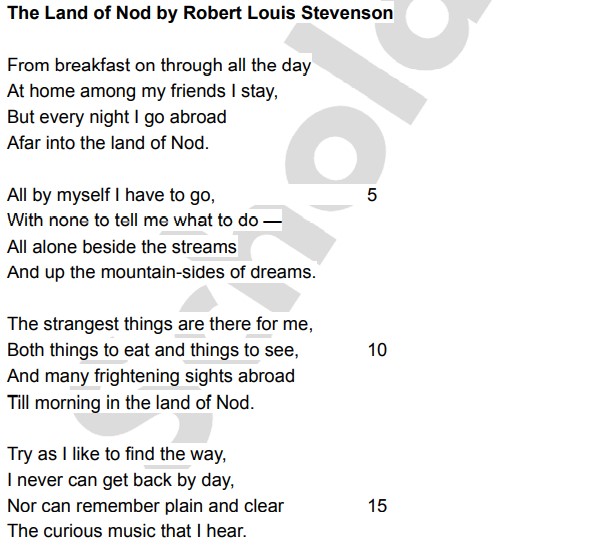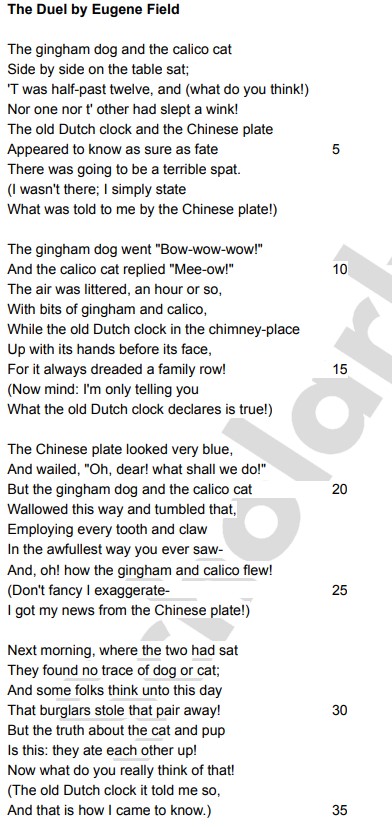DAY 3 Reading Homework
Quiz Summary
0 of 30 Questions completed
Questions:
Information
You have already completed the quiz before. Hence you can not start it again.
Quiz is loading…
You must sign in or sign up to start the quiz.
You must first complete the following:
Results
Results
0 of 30 Questions answered correctly
Your time:
Time has elapsed
You have reached 0 of 0 point(s), (0)
Earned Point(s): 0 of 0, (0)
0 Essay(s) Pending (Possible Point(s): 0)
Categories
- Not categorized 0%
| Pos. | Name | Entered on | Points | Result |
|---|---|---|---|---|
| Table is loading | ||||
| No data available | ||||
- 1
- 2
- 3
- 4
- 5
- 6
- 7
- 8
- 9
- 10
- 11
- 12
- 13
- 14
- 15
- 16
- 17
- 18
- 19
- 20
- 21
- 22
- 23
- 24
- 25
- 26
- 27
- 28
- 29
- 30
- Current
- Review
- Answered
- Correct
- Incorrect
-
Question 1 of 30
1. Question

1. How old do you think the speaker of the poem is?
A. Infant
B. Child
C. Teenager
D. AdultCorrectIncorrect -
Question 2 of 30
2. Question

2. From stanzas 1-3, line 4 of the first stanza mentioned, “foreign lands”. What does this
word signify in the three stanzas?
A. Imaginary world
B. Another country
C. Nearby locales
D. A new provinceCorrectIncorrect -
Question 3 of 30
3. Question

3. Which statement is NOT true based on the poem?
A. The child climbed up a hill and looked around on foreign lands.
B. The child sees the garden next door that is adorned with beautiful flowers and other pleasant
places he had never seen before.
C. The child climbs higher and sees a blue river and dusty roads on which people are walking.
D. The child wishes that if he could go higher he would have loved to see where the river merges
into the sea.CorrectIncorrect -
Question 4 of 30
4. Question

4. How do you interpret the speaker’s conduct throughout the entire poem?
A. The speaker is anxious
B. The speaker is annoyed
C. The speaker is bored
D. The speaker is excitedCorrectIncorrect -
Question 5 of 30
5. Question

5. The poem evokes the following EXCEPT
A. A yearning for adventure.
B. A want to satisfy one’s innocent curiosities.
C. An array of limitless imagination.
D. An agonising feeling of being deprived of the outside world.CorrectIncorrect -
Question 6 of 30
6. Question

6. Which of the themes below is NOT taken from the poem?
I. Senectitude
II. Curiosity
III. Imagination
IV. Adventure
V. ChildhoodA. I and III
B. I only
C. II and IV
D. V onlyCorrectIncorrect -
Question 7 of 30
7. Question


]7. To reflect the city’s beauty, the speaker noted the following EXCEPT
A. The flowering trees
B. The smell of the air
C. The sights and sounds of the city
D. The blueness of the skyCorrectIncorrect -
Question 8 of 30
8. Question


8. What does the word “gay” in line 3 mean?
A. Lively
B. Timid
C. Brilliant in colour
D. CowardlyCorrectIncorrect -
Question 9 of 30
9. Question


9. What does the poem mean when it mentions the “little shower”?
A. A short bath
B. The rain
C. Small bathrooms
D. A baby showerCorrectIncorrect -
Question 10 of 30
10. Question


10. As stated in the poem, what can you say about the weather in Paris?
A. It has been beautifully sunny all day long
B. It has been rainy all day long
C. It has been alternating between rainy to sunny
D. It has been very sunny but feels cold as if it was rainingCorrectIncorrect -
Question 11 of 30
11. Question


11 Which part of speech does the word “Ninette” in line 21 belong to?
A. Pronoun
B. Adjective
C. Noun
D. VerbCorrectIncorrect -
Question 12 of 30
12. Question


12 How does the poem impact readers?
A. The poem opens the readers’ eyes to the different Paris sceneries.
B. The poem forces readers to get a Paris visa as soon as possible.
C. The poem invites readers to a life outside Paris.
D. The poem leaves readers in awe at the beauty of Paris in spring.CorrectIncorrect -
Question 13 of 30
13. Question

13 What does the speaker mean when he says he goes to the land of Nod?
A. The speaker travels to a location where creatures called Nod reside.
B. The speaker nods to show approval.
C. The speaker nods to greet the people he meets.
D. The speaker nods off to sleep to be in the land of dreams.CorrectIncorrect -
Question 14 of 30
14. Question

14 What do lines 1 to 2 try to say about the speaker?
A. The speaker is living an ordinary life.
B. The speaker is an introvert.
C. The speaker is sick.
D. The speaker is not allowed to go out with his friends.CorrectIncorrect -
Question 15 of 30
15. Question

15 Which line indicates when the real world ends and the Land of Nod begins?
A. Line 3
B. Line 7
C. Line 9
D. Line 13CorrectIncorrect -
Question 16 of 30
16. Question

16 In lines 7 to 8, who is all alone beside the stream?
A. The land of Nod
B. The time traveller
C. The speaker
D. The lionCorrectIncorrect -
Question 17 of 30
17. Question

17 From the poem, which of the following contrasts the real world and the land of Nod?
A. The real world is lonely, while the Land of Nod is strange.
B. The real world is homey and friendly, while the Land of Nod is strange and frightening.
C. The real world is exciting and scary, while the Land of Nod is boring and ordinary.
D. The real world is boring and ordinary, while the Land of Nod is exciting and scary.CorrectIncorrect -
Question 18 of 30
18. Question

18 After reading the poem, what do you think dreams can do for us, humans?
A. Dreams help us analyse memories.
B. Dreams help us escape from our own normal lives into something amazing.
C. Dreams help lessen the emotional tone of our memories.
D. Dreams are like rehearsals for different situations and challenges that people face in real lifeCorrectIncorrect -
Question 19 of 30
19. Question

19 What is the poem all about?
A. The duel between the old Dutch clock and the Chinese plate.
B. The observant nature of the old Dutch clock and the Chinese plate.
C. The adventures of the gingham dog and the calico cat.
D. The fight between the gingham dog and the calico cat.CorrectIncorrect -
Question 20 of 30
20. Question

20 Who among the following characters told the speaker about the duel?
I. The gingham dog
II. The calico cat
III. The chimney-place
IV. The old Dutch clock
V. The Chinese plateA. I and II
B. II and III
C. III and IV
D. IV and VCorrectIncorrect -
Question 21 of 30
21. Question

21 What figure of speech is used in lines 18 to 19?
A. Simile
B. Metaphor
C. Personification
D. OnomatopoeiaCorrectIncorrect -
Question 22 of 30
22. Question

22 How do the last two lines of each stanza impact the poem?
A. This helps the speaker remind the readers that he was not physically present during that duel.
B. This encourages the speaker to continue talking about the rumours of the duel.
C. This highlights how the Chinese plate and the old Dutch clock exaggerate stories.
D. This shows that the Chinese plate and the old Dutch clock were both big gossipersCorrectIncorrect -
Question 23 of 30
23. Question

23 Which of the following is a theme used in the poem?
A. Vermins
B. Animals
C. Avarice
D. NostalgiCorrectIncorrect -
Question 24 of 30
24. Question

24 Among the many speculations, the following scenarios happened to the characters
involved in the duel at the end of the poem EXCEPT
A. Some burglars might have broken into their houses and taken them
B. None could find traces of them
C. The two forfeited the match at the same time
D. They ate up each other upCorrectIncorrect -
Question 25 of 30
25. Question

25 The following themes are used in the poem EXCEPT
A. Ownership
B. Environment
C. Citizenship
D. NatureCorrectIncorrect -
Question 26 of 30
26. Question

26 Who do you think is the speaker of the poem?
A. Mother Earth
B. A whale
C. An animal
D. A personCorrectIncorrect -
Question 27 of 30
27. Question

27 What does the adjective “blackened” try to mean in line 16?
A. The black wind that is caused by strong tornadoes.
B. The greying of the clouds when storms are approaching.
C. The splash of colours artists use in painting the air on canvases.
D. The dirty smoke in the air that is caused by people and factories.CorrectIncorrect -
Question 28 of 30
28. Question

28 Lines 5 to 6 talk about the seal’s fur. Why do people want their fur?
A. They think it is very cute and fluffy.
B. They want to use it to make items like coats.
C. They find it mesmerising to look at.
D. They like to show it off to their parents.CorrectIncorrect -
Question 29 of 30
29. Question

29 How does the poem impact its readers?
A. It motivates readers to compare life before and after fifty years.
B. It encourages readers to continue observing the changes in the environment.
C. It calls readers to stand up for the future of our planet and help to save our world.
D. It does not have any impact at all.CorrectIncorrect -
Question 30 of 30
30. Question

30 What type of imagery is used in lines 13 to 14?
A. Tactile
B. Olfactory
C. Visual
D. AuditoryCorrectIncorrect